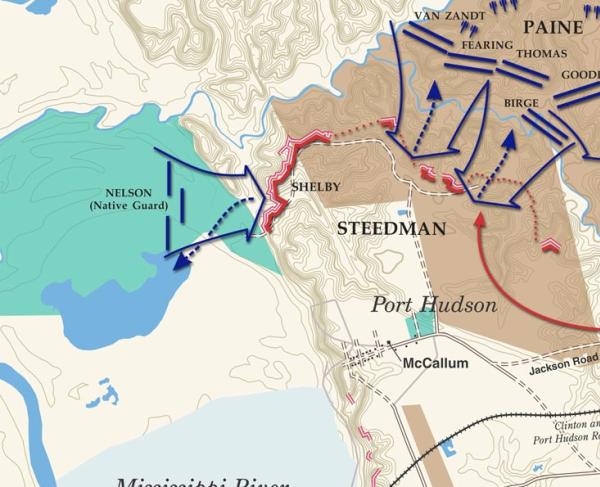
Mansfield Battlefield, DeSoto Parish, La.
Protecting the Past: 22 Acres Saved at Port Hudson and Mansfield
Full of cultural and geographical variations, Louisiana contains 31 principal battlefield sites tied to the Revolutionary War, War of 1812 and the Civil War. With its recent addition of 2.57 acres at Port Hudson and nearly 20 acres at Mansfield, the American Battlefield Trust has arrived at a preservation total of almost 772 acres of hallowed ground saved throughout the Bayou State.
The majority of this Louisiana land was protected through strides made at Port Hudson and Mansfield. Since 1993, the Trust has saved 258.57 acres at the former. The latter encompasses even more land, with 459.29 acres preserved. Carrying priceless value that adds to the state’s expansive history, these battlefields — both state historic sites — will now grow and augment opportunities for visitors to discover the many stories ingrained in the soil.
Port Hudson: May 21 - July 9, 1863
Port Hudson was one of the most hotly contested locations in America during the spring and early summer of 1863. Along with Vicksburg, its big brother to the north, this southern stronghold was critical to Confederate efforts to maintain control of the Mississippi River. In May 1863, federal forces under Gen. Nathaniel Banks launched a string of uncoordinated and unsuccessful assaults, eventually settling in to a 48-day siege. Each side had their own set of siege tactics: the Union preferred siege guns and mines; the Confederates employed trench raids and reused spent ammunition. With the fall of Vicksburg on July 4, Port Hudson’s fate was sealed – the southern citadel surrendered on July 9, 1863, giving Federals control of the “Mighty Mississippi” and dividing the Confederacy in two.
The now-preserved 2.57-acre tract here fell well within the Confederates’ defenses and was bombarded almost nonstop during the siege. But the property also contains a portion of the post-siege earthworks that were constructed by the Union’s Corps d’Afrique, a unit that later became better known as part of the U.S. Colored Troops. In fact, during the early Union assaults on Port Hudson, the 1st and 3rd Louisiana Native Guard were among the first Black soldiers engaged in major combat actions during the Civil War. The Trust has now saved 258.57 acres at Port Hudson, a preservation legacy that began all the way back in 1993.
Join 2021-22 Youth Leadership Team members (and Louisianans) Alexis Ellis and Sean Myers, who travelled to the Port Hudson State Historic Site to tell viewers more about its significance.
Located less than a half-hour away from the state capital of Baton Rouge, Port Hudson marks where Black soldiers engaged some of the first major combat actions during the Civil War. Explore this victory with members of the Youth Leadership Team.
American Battlefield TrustMansfield: April 8, 1864
With the objective to capture Louisiana’s Confederate capital at Shreveport and open the gateway for Federal troops to enter Texas, Union forces launched the Red River Campaign in the spring of 1864. However, forces under Maj. Gen. Richard Taylor stood as a roadblock to Shreveport when they forced the retreat of Maj. Gen. Nathaniel P. Banks’s Union forces at the Battle of Mansfield on April 8, 1864.
The recently acquired nearly 20-acre tract covers land tied to the second phase of the 1864 battle, which caused Banks and his men to ultimately withdraw. However, the opposing forces met again the following day at Pleasant Hill.
This recent accomplishment at Port Hudson and Mansfield wouldn’t have been possible without the support of the American Battlefield Protection Program, the State of Louisiana and the Trust's devoted donors.
The Trust is determined to strengthen interpretation at seven battlefields — including Port Hudson — that bear ties to Black service in America’s first 100 years. This work is coming alive through its Fighting for Freedom fund, and thanks to a grant from the American Battlefield Protection Program, donations to the fund can be matched dollar-for-dollar. To learn more or make a donation, you can visit www.Battlefields.org/FightingForFreedomFund.


